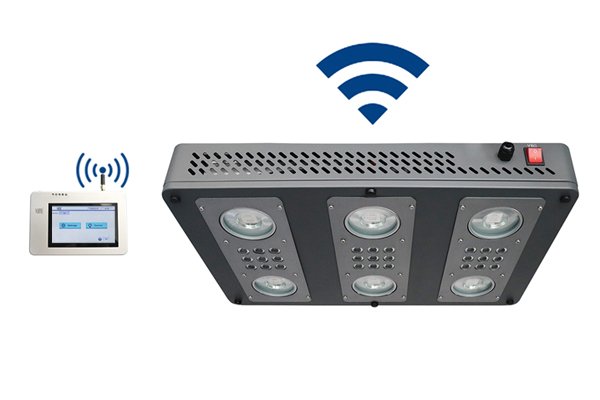COB is the abbreviated form of Chip on Board LED light that offers many pluses over conventional LED lights. COB LED's are relatively novel to the LED's market place and tremendously innovative for indoor growers. The primary reason why they are so helpful for indoor growing is their multiple LED chips fused with the substrate to form a single unit. It is not the type of structure found in traditional LED's. COB LED's structure uses chips that don't pack traditionally in individual light and could mount in such a way that it takes little space, and the uppermost prospective of the chips is acquired. When a COB LED is electrified, it gives the shape like a
When the COB LED package energizes, it appears more like an illuminating plate rather than multiple lights as the SMD lights behave when tightly packed together in a panel. The practice of using the COB LEDs for indoor farming is gaining popularity and success over the traditional LED lights for realizing their benefits in the tight spaces for the bigger productions. With their facility to fold more LED's into a smaller space, the Lumens output remains high and their tendency to throw heat more efficiently to a sink. Moreover, their simple design reduces their failure percentile along with a low energy loss whereas, their viewing angles get fairly increased that enhances its growing footprint in a grow room. It looks pretty hard for the indoor growers not to think through multiple advantages that they could harvest for growing in a modified environment.
Due to the multi-chips, the light discharging areas of a COB LED's would release much more light in a similar area than conventional LED's and would be responsible for increasing Lumens output per square feet. This capability increases their footprint otherwise, not attainable through an ordinary LED light.
Generally, COB LEDs working based on a single circuit with two contacts that electrifies the multiple diode chips which, require fewer apparatuses for an independent LED chip to operate, properly. Additionally, the lesser components, along with the abolition of the conventional LED chip frame wrapping, could reduce the heat emitted from an individual LED chip. The ceramic or metal insulations in COB LEDs also behave as a highly efficient heat transmission medium when attached to an external heatsink, further decreasing the operating temperature in its system. When a COB LED is supposed to be mounted to a heatsink, it must have the potential to dissipate maximum heat so that the COB runs at full capacity yielding maximum performance. In due course, it lowers the system failure rates and increases the efficiency of a COB LED. An alternative feature of the COB LEDs that reduces failure is the spot fusing of each LED chip with an insulator. Small connections and miniature welding save it from failures.
The COB LED Grow Light features become more valuable when you have total control over the angle to throw light on your plants such as marijuana and a mandatory switch to control brightness and wavelength during different stages of growth and development. Moreover, it more advantageous to install a timer that keeps control over the lighting intervals during variable processes. We are privileged to add a COB LED Grow Light in our fleet of several LEDs that hold the features of wireless programming whereas, its fixture allows controlling all 4 spectra of light along with UV+white that plants admire throughout their growth processes. GLIC650D 650Watts holds all these features and several others that determine the success of cannabis grown in a control room under artificial light. Commercial cannabis growers love its 120º wide-beaming angle design with a marvelous footprint 4ft(1.2m) x 4ft(1.2m) at 18 inches’ height.

Its source contains 6 pieces of 100 Watts COBs and 27 pieces of independent LED. whereas, the chip manufactured by Bridgelux, Epileds. Moreover, an individual light possesses 3 cooling fans for the bigger heatsink.
Another issue of running your system on battery power resolves. It was in the observation that the brightness of a traditional LED's compromises when running the system on battery power. Additionally, a quality Lumen and runtime also decreases while shifting them to the battery power. Generally, the desired brightness discharges battery power more rapidly in conventional LED's. On the other hand, with the help of modern inputs in the new editions of COB LED Grow Lights, this difficulty eliminated. Now Low wattage COB LEDs would discharge extremely superior quality bight light that the cannabis growers dream off. They could address this issue by using a small Lithium-ion battery to electrify their COB LED’s saving a lot on their electricity bills.























